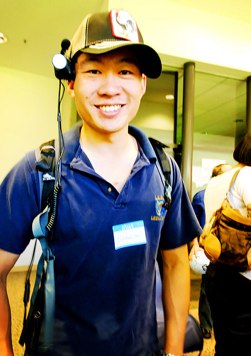TC
Auto Added by WPeMatico
Auto Added by WPeMatico
In a world where large hyperscale companies like Amazon, Microsoft and Google dominate the public cloud, it would seem foolhardy for a startup to try to carve out a space, but Packet has an alternative customized cloud vision, and investors have taken notice. Today, the company announced a $25 million Series B led by Third Point Ventures.
An interesting mix of strategic and traditional investors joined the round including Battery Ventures, JA Mitsui Leasing and Samsung Next. Existing investors SoftBank Corp. and Dell Technologies Capital also participated. The company has now raised over $36 million.
The company also showed some signs of maturing by bringing in Ihab Tarazi as CTO and George Karidis as COO. Tarazi, who came over from Equinix, likes what he sees in Packet .
He says they offer several advantages over the public providers. First of all, customers can buy whatever hardware they want. “We offer the most diverse hardware options,” he said. That means they could get servers equipped with Intel, ARM, AMD or with specific nVidia GPUs in whatever configurations they want. By contrast public cloud providers tend to offer a more off-the-shelf approach. It’s cheap and abundant, but you have to take what they offer, and that doesn’t always work for every customer.
Another advantage Packet bring to the table, according to Tarazi, is that they support a range of open source software options, letting customers build whatever applications they want on top of that custom hardware.
They currently have 18 locations around the world, but Tarazi said they will soon be adding 50 more, also adding geographic diversity to the mix.
Finally, each customer gets their own bare metal offering, providing them with a single tenant private option inside Packet’s data center. This gives them the advantages of a privately run data center but where Packet handles all of the management, configuration and upkeep.
Tarazi doesn’t see Packet competing directly with the hyperscale players. Instead, he believes there will be room for both approaches. “I think you have a combination of both happening where people are trying to take advantage of all these hardware options to optimize performance across specific applications,” he explained.
The company, which launched in 2014, currently has about 50 employees with headquarters in New York City and offices in Palo Alto. They are also planning on opening an operations center in Dallas soon. The number should swell to 100 employees over the next year as they expand operations.
Powered by WPeMatico
Much like smartphone manufacturers, drone companies have been adding to devices plenty of features over the past several years while making only modest improvements to battery life. But while your phone may boast “all-day” usage, a lot of the top drones only register flight times between 20-35 minutes.
Impossible Aerospace is looking to change up that equation, at least when it comes to commercial drones, with a dense design that is basically all battery. The company shared launch details of its US-1 drone today, and announced that it had closed a $9.4 million Series A from Bessemer Venture Partners, Eclipse Ventures and Airbus Ventures.
Its first product is a drone that can most notably stay airborne for about 120 minutes in optimal flying conditions, with a 75km (over 46 miles) straight-line range. It can carry 2.9 pounds of payload, but that drops the total flight time to 78 minutes.

For commercial customers, the added flight time can dramatically free up use cases, changing the mindset of operation from mission-based to much more exploratory.
The company’s website has an almost comical X-ray diagram of the US-1’s battery makeup showcasing a design that just looks like a big “X” of battery cells. Around 70 percent of the 15-pound drone’s weight is lithium-ion batteries, the company tells me.
This is a design built for old-school drone pilots; in order to achieve their lengthy flight time they had to ditch some additional components, the most controversial choice probably being the lack of any onboard obstacle-avoidance sensors. “Every aircraft design is a compromise,” Impossible Aerospace CEO Spencer Gore told TechCrunch in an interview. “There’s nothing that’s harder than to figure out what features you will include for some users that hurts the performance for everybody else that’s not going to use them.”
Gore said there were certain features the startup knew it wanted to drill down with its first drone and that the company had an “exciting product roadmap” of designs that made some different choices.
The US-1 starts at $7,500 and will ship in Q4 of this year.
Powered by WPeMatico
Everyone could use an executive coach — even executive coaches.
Such is the thinking of Christine Tao and Lori Mazan, co-founders of Sounding Board, a two-year-old, San Francisco-based marketplace focused on leadership coaching that has so far raised $1 million in seed funding led by Bloomberg Beta, with participation from Precursor Ventures and numerous angel investors.
Some of these investors are people Tao met while an SVP at the mobile advertising startup TapJoy. TapJoy is also where Tao met Mazan, who has been helping companies develop their talent for more than 20 years. “Lori started out coaching our CEO, then coached me when I got promoted into the executive management team,” says Tao.
In fact, Mazan is continuing to coach some of the roughly 30 executive coaches who work with Sounding Board as contractors, and she isn’t alone, says Tao, noting that many of the startup’s senior coaches work with more junior coaches. (Sounding Board’s eight full-time employees also receive coaching.) “We definitely walk the walk,” says Mazan.
They also talk the talk, as we discovered in chatting with Tao and Mazan earlier today about the importance of coaching — and why more employers would be silly not to take advantage of it to help a range of people within their organizations.
TC: There are so many coaching startups. How do you distinguish Sounding Board from everything else out there?
CT: We combine best-in-class coaches with a tech platform that’s scalable and affordable and outcome-oriented. It’s also a lot more cost-effective compared with other coaching platforms.
TC: How much more affordable?
CT: A weekend of traditional executive coaching in the Bay Area costs between $25,000 and $30,000. We’re about a tenth of that price, and instead of sending someone to a workshop for a couple of days, you pay the same for six months of training with us.
LM: We’re modeled after traditional coaching engagements, including at Chevron, Genentech and a lot of other big oil and manufacturing and biotech companies where I’ve worked over the years. What we’ve done is take what worked at the top of the house and just bring it down to lower managers and senior leaders.
TC: You work with both big and small companies — from the Japanese giant Rakuten to venture-backed Quantcast. Which is the easier sale?
CT: Hah. Both venture-backed companies and bigger enterprises go through huge periods of growth and they elevate folks into leadership roles in which they don’t have experience. High-growth startups innately feel the pain of having talented folks in roles for which they have no skills. On the other hand, public companies often are easier, given that they have a budget and they’re used to investing in training and developing employees.
TC: Do you tend to coach one person at a time or do you do your coaching in batches?
CT: We typically teach a cohort over a six-month period, where the employees are meeting with a coach who has been chosen based on their particular needs and learning styles and [with whom they interact] via video or phone and who they engage any time through Slack or email. When a company on-boards with us, we collect a lot of data around key leadership values and goals, including from managers — they let us know what goals they have in mind for a person’s leadership development. And that person [who will be coached] provides us insights into their personal goals as well.
TC: For people who haven’t had coaching, it all sounds awfully squishy. What are some concrete ways in which the coaching will change based on the individual?
LM: We have 12 developmental areas, and each is personalized for an individual. One of the most popular has to do with managing up and across an organization, meaning we work with people wanting to have influence with their manager and their peers and maybe even their manager’s peers across the organization.
Every approach will be different, including based on whether the person is working in a very high-pressure, fast-paced environment or a more slow-paced and amiable one. It’s also very different if you’re in engineering versus sales, for example. Let’s say you’re in sales and you want to influence your boss. You might need to paint a bigger picture and give examples around how your vision will improve the quota you need to make. On the engineering side, it’s likely that you’ll have to be very detailed.
CT: When Lori coached me, we worked on language I used when talking with one of my CEOs, down to incredibly minute details around the order in which I presented ideas. It made a huge difference. Whereas the feedback was that this person felt like I would dump my problems on him, by instead providing recommendations up front to him and offering many fewer details, he thought I was being more “solutions oriented.” The reality was that I was mostly sharing the same things.
Powered by WPeMatico
What happens when you add AI to food? Surprisingly, you don’t get a hungry robot. Instead you get something like PixFood. PixFood lets you take pictures of food, identify available ingredients, and, at this stage, find out recipes you can make from your larder.
It is privately funded.
“There are tons of recipe apps out there, but all they give you is, well, recipes,” said Tonnesson. “On the other hand, PixFood has the ability to help users get the right recipe for them at that particular moment. There are apps that cover some of the mentioned, but it’s still an exhausting process – since you have to fill in a 50-question quiz so it can understand what you like.”
They launched in August and currently have 3,000 monthly active users from 10,000 downloads. They’re working on perfecting the system for their first users.

“PixFood is AI-driven food app with advanced photo recognition. The user experience is quite simple: it all starts with users taking a photo of any ingredient they would like to cook with, in the kitchen or in the supermarket,” said Tonnesson. “Why did we do it like this? Because it’s personalized. After you take a photo, the app instantly sends you tailored recipe suggestions! At first, they are more or le
ss the same for everyone, but as you continue using it, it starts to learn what you precisely like, by connecting patterns and taking into consideration different behaviors.”
In my rudimentary tests the AI worked acceptably well and did not encourage me to eat a monkey. While the app begs the obvious question – why not just type in “corn?” – it’s an interesting use of vision technology that is definitely a step in the right direction.
Tonnesson expects the AI to start connecting you with other players in the food space, allowing you to order corn (but not a monkey) from a number of providers.
“Users should also expect partnerships with restaurants, grocery, meal-kit, and other food delivery services will be part of the future experiences,” he said.
Powered by WPeMatico
While many lament the death of local news, a small army of tech startups has been developing a new set of tools to figure out how to save it. In one of the latest developments, Hoodline — which has built a platform to ingest and analyse hundreds of terabytes of data to find and then write local news stories — has raised $10 million in a Series A round to help take its effort nationwide.
“We want to cover the news deserts that no one else is covering,” said Hoodline’s founder and CEO Razmig Hovaghimian. “It’s filling a gap. It’s filling a need.”
The San Francisco startup had once been called Ripple News (in reference to the news that “ripples out” from one event) but then took the name of a hyperlocal news blog network (cofounded by Eric Eldon, formerly of TechCrunch) that it acquired in 2016 after another Ripple began to make waves.
It is currently generating stories in 20 cities, with ABC, MSN, Yahoo, Hearst and CBS among the publishers that are partnering with Hoodline to use its content.
This latest Series A round was led by Neoteny, a seed and early stage investment firm out of Boston whose founder and lead partner, MIT Media Lab director Joichi Ito, is also joining Hoodline’s board.
Sound Ventures, Dentsu Ventures and Eric Schmidt’s Innovation Endeavors also participated, among other investors who asked not to be named.
Hoodline had been a part of Disney’s accelerator in 2017, so it too has backed the company, as has Rakuten, the Japanese e-commerce behemoth that acquired Hovaghimian’s previous startup, the crowdsourced online video subtitling startup Viki.
Hoodline is not disclosing its valuation, but from what we understand, it’s around $75 million and a bump up from its previous valuation.
Hoodline’s platform today has two parts: a local data wire producing local news stories; and a recommendation module that is somewhat similar to the likes of Outbrain and Taboola. Rather than recirculating stories from a wider network of clickable sites, however, it suggests stories from Hoodline’s inventory, alongside a publication’s own articles, to keep people engaged on a site for longer.
Hoodline inks free partnerships with media platforms to supply content for the first part; the second part has ads running alongside the recommended articles.
One of the big issues with local news and its decline is that, as more traditional publishers have moved to the internet to cut the costs of producing printed newspapers, they’ve found that the revenues and margins that they generated from the older activities have not translated to the newer medium.
Moreover, the issues of slim margins on ads that even exist for large, world-famous publications are only compounded for smaller ones: they have a hard time getting the economies of scale needed to make the ad-based model work. And then, even if they club together, they have to contend with the fact that their readerships have moved on to other forms of infotainment.
But as it turns out, there is still an appetite for local information.
“There are so many good stories that go uncovered,” Hovaghimian said. “Plus, forty percent of all searches have local intent.” Facebook’s new interest in local news and Google’s own experiments with local journalism aren’t simple good-will attempts at fostering more community; they reflect interests that these companies have observed among their user bases.
So now, while tech has arguably “killed” the local news business, it’s also been trying to save it — namely, in the form of providing more intelligent ways to run the news business, from the advertising technology and/or paywalls to fund it, through to disrupting and improving the means of producing it.
Hoodline is part of the new guard of media tech companies that has been looking at how the rise of technologies like AI and big data analytics can be used to help with the latter of these.
“Hoodline is bringing pioneering technology to the world of hyper-local news and content, while layering in editorial expertise and perspective. This uniquely allows them to craft dynamic stories across a wide range of verticals and outlets,” said Ito in a statement. “We’re incredibly excited to be partnering with Hoodline and Razmig as they continue to deliver consumers content that they want, but was previously not available to them.”
Hoodline is not the only one exploring how to tap into big data to build stories; there are many.
Among them, in the UK, the Press Association is working with a startup called Urbs to develop AI systems that can help surface interesting stories for (human) journalists to write. In the US, Automated Insights has been developing “robot” reporters to cover local sports and quarterly earnings beats.
Other efforts like LiveStories is also tackling a trove of publicly available information — in its case civic data — to visualise and shape narratives from it, products that potentially also make their way into the news.
Hovaghimian said that Hoodline’s system ingests around 250 terabytes of data from a pretty diverse range of sources, spanning from hyperlocal listings services like Yelp and Foursquare through to things like feeds of local high school football sports results. This is organised and passed through algorithms to surface interesting items that can be used in stories.
Editors, meanwhile, write templates that can be used for different types of stories, such as local food events, job trends in a particular city, or sports results from a local team. One person at the company described these templates as “advanced Madlibs.”
And for now, it’s as basic as this, too. Hoodline has bylined content written by journalists, but the content that is bylined to Hoodline is created by the company’s big data platform.
Those articles, it has to be said, are more anodyne than earth-shattering. But Hovaghimian says this is almost intentional, it’s to clear the way for more serious work.
“We are filling a gap and covering news that is not being covered, even if it’s just to test what audiences want to read,” he said. “This frees up resources for more journalistic pursuits.”
Whether or not publications dedicate resources to more journalistic pursuits to complement the Hoodline work, of course, is another matter.
Meanwhile, Hoodline also has journalists working on original content and to build these templates. The company currently has a ratio of around two engineers to one editor, Hovaghimian said, but believes that as it scales it will be bringing in fewer editors and more engineers: “At this point, it’s about growth now that we have figured out what our bottlenecks are,” he said.
As for what comes next, Hovaghimian said that the ambition is to bring this to more than just the US eventually, and to work with different kinds of partners beyond news organizations. Facebook and Google’s own interests in this area haven’t gone unnoticed and the company has thought about how it could partner with them, too.
Powered by WPeMatico
Snapchat is hedging its bets as its social network shrinks. Today Snap Inc. revealed the first class of its startup accelerator called Yellow that offers $150,000 in funding and creativity-centric business education in exchange for what a source says is a seven to 10 percent equity stake — in line with other accelerators like Y Combinator. The nine companies will take up a three-month residency in one of Snap’s buildings in Venice, Calif., near Los Angeles.
The accelerator class ranges from augmented reality and journalism studios to lifestyle brands around weddings and fashion to aesthetic-focused marketplaces like ConBody that pairs you with a muscular ex-convict for workouts.
Yellow calls itself “A launchpad for creative minds and entrepreneurs who are looking to build the next generation of great media companies.” Yellow could become a content provider and potential acquisition feeder for the company. ANRK and Space Oddity Films could boost Snapchat’s AR gaming effort, Hashtag Our Stories could fill Snap Map with citizen news broadcasts, Toonstar could bring animation to Discover, and SelfieCircus could power marketing pop-ups like the Snapbots that sold the company’s Spectacles.

But at the same time, it’s hard not to see Yellow as a potential escape route for Snap’s business if Instagram’s competition ends up stealing all its users. Snapchat lost three million last quarter, contributing to a massive share price downslide. Following today’s departure of COO Imran Khan, it’s trading at $9.66, just a few cents above its all-time low.
If a few of Yellow’s investments blow up and Snap makes capital available for follow-on rounds, the returns could supplement its ad revenue. But none of this first batch of startups looks poised to be gamechangers the way Snap’s acquisitions of Bitmoji and Looksery’s early AR filters were.
Here’s a look at the first nine companies in Snapchat Yellow, courtesy of write-ups provided by Snap.
ANRK (London, UK) – a new realities studio, exploring immersive storytelling through AR, VR, games and beyond.

ConBody (New York, NY) – a prison-style fitness bootcamp that hires formerly incarcerated individuals to teach fitness classes.
ConBody is facilitating an opportunity-filled lifestyle by empowering our community to realize success lies within. We hire formerly incarcerated individuals to build personal discipline through a unique blend of cardiovascular training and bodyweight exercises that take advantage of the resistance properties of everyday objects. We apply military techniques to space constraints intimately familiar to city-dwellers and individuals who reside in small, constrained spaces. In addition, we’re changing the views of formerly incarcerated individuals to be changed by allowing professionals to interact with formerly incarcerated individuals, which gives professionals a different perspective on them.

ConBody
Hashtag Our Stories (Durban, South Africa) – an international mobile journalism (MOJO) network, publishing vertical video stories on social media. Created by citizens, curated by journalists.
Since September 2017, we’ve empowered 200 citizen storytellers in over 40 countries to produce videos with their phones. We focus on constructive, solutions-based stories and provide more diverse news coverage. Because more cameras and more perspectives means more truth.

Hashtag Our Stories
IDK (Los Angeles, CA) – the ID for Korean music. We are a digital media company expanding in-depth on the music of Korea and K-Pop as a globally recognized genre; showcasing the identity of the artists that shape the culture. We provide insightful and rich coverage and content for the global Korean Pop audience.
We are creating a Global Brand and Destination for an English-Speaking Korean Pop Audience. Our mission is to create rich and stylized content about the Korean Music Genre; less gossip, more news and features. We want to provide a legitimate outlet for Korean Pop Culture; to create emotive, aspirational stories that are visually chic to a young, hyper-aware and digitally engaged audience.
As the company begins we will focus on publishing the best in engaging social video content. We will translate this content across platforms, ultimately building brands, shows and stories that feed the insatiable audience appetite for Korean Pop. From there we will build toward live events, merchandise and much more.
Love Stories TV (New York, NY) – a video platform for wedding planning and inspiration, bringing engaged couples and event professionals together in a uniquely visual community. Think of us like “Houzz” for weddings: We connect brides and grooms with the ideas, inspiration, products and services they need for their weddings. [Note: Snap tells me Love Stories TV did not give up a seven to ten percent equity stake as it had previously raised a $1.7 million seed round, but wouldn’t disclose more details about its equity stakes in the other startups.]
On lovestoriestv.com filmmakers and newlyweds from all over the world share their professionally produced videos along with the data and details about the wedding. Brides and grooms watch the videos to find ideas, inspiration, products and services for their wedding. We also have an active community of pre-engaged-brides under the age of 24 who watch the videos on our site, social and Amazon Prime channel for entertainment. We partner with brands and wedding pros to help them reach brides and grooms on our site and channels via the real wedding films that feature them and original content.

Love Stories TV
Premme (Los Angeles, CA) – a fashion-first, body-positive lifestyle brand for the plus-size It-Girl.
Today, 67 percent of women in America wear plus-sizes — yet plus-size fashion only accounts for 17 percent of the women’s apparel market. When it comes to media representation, plus-sizes are similarly lacking in positive, aspirational visibility. Premme empowers women who have been historically marginalized through fashion-forward, statement-making clothing and visionary, contemporary editorial content and imagery. By creating a relatable, yet aspirational brand that centers on plus-size women, we aim to flip the script on what it means to look and be stylish, while leading the conversation and movement toward truly diverse and inclusive fashion.

Premme
SelfieCircus (Los Angeles, CA) – a new kind of circus.
SelfieCircus creates pop-up experiences designed to be documented and shared on social media. The company is building a platform to connect artists, brands and consumers. The first SelfieCircus will open in Los Angeles in late 2018.

SelfieCircus
Space Oddity Films (Los Angeles, CA) – a content studio exploring tech and culture that creates innovative content for every platform: mobile, digital, AR/VR, video games, feature film and television.
We tell stories about the convergence of humanity and technology. Our original viral tech horror thriller shorts are the foundation of our brand. Our goal is to make the future now.

Space Oddity Films
Toonstar (Los Angeles, CA) – a digital animation network that creates and distributes daily pop culture cartoons for an “always on” world. Powered by proprietary animation tech, we produce daily, snackable, interactive animated content at unprecedented speed and cost.
We have a large and highly engaged audience of teens and young adults generating millions of views per week because our content is sticky, shareable, relatable and engineered specifically for social. We’re a team of studio alumni and media tech innovators who have produced hit digital animated series, built groundbreaking interactive media technologies and launched mega entertainment franchises. Now we’re on a mission to build a next-gen animation network that delivers greater reach + engagement at a fraction of the operating cost.

Toonstar
Powered by WPeMatico
Evaneos, the online marketplace for tailor-made travel experiences, has picked up $80 million in Series D funding. Leading the round is Partech, and Level Equity, with participation from Quadrille Capital, and existing backers XAnge, Serena Capital, and Bpifrance.
The injection of cash is to be used to international development, including increasing headcount from the current 180 employees. It brings total funding to around $108 million since being founded in 2009.
Competing primarily with traditional tour operators, Evaneos offers a marketplace for tailored travel experiences that claims to cut out the middle-person -– that is, the tour operators and major travel agencies -– by connecting travellers directly with a community of local travel agents. Through the site you can browse a range of holiday ideas, then contact a local agent living in the destination country to design a tailor-made itinerary.
The draw for consumers is more personalized travel experiences, while local agencies benefit from an additional source of direct revenue, retaining more income for the local economy. Evaneos counts 1,300 local partners based in 160 destinations, and says it aims to add another 500 in 2009.
The product is available in 9 European countries, and Evaneos name checks Germany, France, Italy, Spain & the U.K. as particularly competitive but where it is seeing most business. To date, more than 300,000 travellers have used Evaneos to create and book a trip.
Meanwhile, personalised travel remains a hot sector for investors. In June, TourRadar, the Vienna, Austria-headquartered online travel agency (OTA) that also targets the multi-day touring market, raised $50 million in Series C funding led by the Silicon Valley growth VC firm TCV.
Powered by WPeMatico
Intel today is announcing another acquisition as it continues to pick up talent and IP to bolster its next generation of computing chips beyond legacy PCs. The company has acquired NetSpeed Systems, a startup that makes system-on-chip (SoC) design tools and interconnect fabric intellectual property (IP). The company will be joining Intel’s Silicon Engineering Group, and its co-founder and CEO, Sundari Mitra, herself an Intel vet, will be coming on as a VP at Intel where she will continue to lead her team.
Terms of the deal are not being disclosed, but for some context, during NetSpeed’s last fundraise in 2016 (a $10 million Series C) it had a post-money valuation of $60 million, according to data from PitchBook.
SoC is a central part of how newer connected devices are being made. Moving away from traditional motherboards to create all-in-one chips that include processing, memory, input/output and storage is an essential cornerstone when building ever-smaller and more efficient devices. This is an area where Intel is already active but against others like Nvidia and Qualcomm many believe it has some catching up to do, and so this acquisition in important in that context.
“Intel is designing more products with more specialized features than ever before, which is incredibly exciting for Intel architects and for our customers,” said Jim Keller, senior vice president and general manager of the Silicon Engineering Group at Intel, in a statement. “The challenge is synthesizing a broader set of IP blocks for optimal performance while reining in design time and cost. NetSpeed’s proven network-on-chip technology addresses this challenge, and we’re excited to now have their IP and expertise in-house.”
Intel has made a series of acquisitions to speed up development of newer chips to work in connected objects and smaller devices beyond the PCs that helped the company make its name. Another recent acquisition in the same vein include eASIC for IoT chipsets, which Intel acquired in July. Intel has also been acquiring startups in other areas where it hopes to make a bigger mark, such as deep learning (case in point: its acquisition of Movidius in August).
NetSpeed has been around since 2011 and Intel was one of its investors and customers.
“Intel has been a great customer of NetSpeed’s, and I’m thrilled to once again be joining the company,” said Mitra, in a statement. “Intel is world class at designing and optimizing the performance of custom silicon at scale. As part of Intel’s silicon engineering group, we’re excited to help invent new products that will be a foundation for computing’s future.”
Intel said it will to honor NetSpeed’s existing customer contracts, but it also sounds like it the company will not be seeking future business as Intel integrates the company into its bigger business.
Powered by WPeMatico
False rumors forwarded on WhatsApp have led angry mobs to murder strangers in India, but the Facebook-owned chat app is still racing to add users in the country. Today it launched a feature phone version of WhatsApp for JioPhone 1 and 2’s KaiOS, which are designed to support 22 of India’s vast array of native languages. Users will be able to send text, photos, videos and voice messages with end-to-end encryption, though it will lack advanced features like augmented reality and Snapchat Stories-style Status updates.
WhatsApp was supposed to launch alongside the JioPhone 2 that debuted last month for roughly $41, but was delayed. Forty million JioPhone 1s had already been sold, and it’s been estimated to control 27 percent of the Indian mobile phone market and 47 percent of the country’s feature phone market. Coming to JioPhone should open up a big new growth vector for WhatsApp as it strives to grow its 1.5 billion user count toward the big 2 billion milestone. Meanwhile, it could make the Reliance-owned Jio mobile network more appealing. It also could strengthen the KaiOS operating system, developed by a San Diego startup of the same name that recently took a $22 million investment from Google. WhatsApp rolls out on the JioPhone AppStore today and should be available to everyone by September 20th. The companu wouldn’t say if the app will come to other KaiOS devices made by Nokia and Alcatel.
Meanwhile, it could make the Reliance-owned Jio mobile network more appealing. It also could strengthen the KaiOS operating system, developed by a San Diego startup of the same name that recently took a $22 million investment from Google. WhatsApp rolls out on the JioPhone AppStore today and should be available to everyone by September 20th. The companu wouldn’t say if the app will come to other KaiOS devices made by Nokia and Alcatel.
Facebook has started to squeeze WhatsApp, replacing its departed co-founders with Chris Daniels, who formerly ran the Internet.org and Free Basics accessibility initiative that got kicked out of India over net neutrality concerns. That doesn’t bode well for him now overseeing WhatsApp’s high-risk/high-reward scenario in India. The massive nation is core to the chat app’s growth strategy, but the attacks it’s spurred have lost it India’s hearts and minds.
WhatsApp has scrambled to safeguard its app after numerous reports of rumors circulated on its app about gangs and child abductors led angry mobs to kill people in the streets. Five nomads were recently beaten to death in the rural village of Rainpada after residents watched inaccurate videos forwarded through WhatsApp about kidnappers supposedly rolling through the area, BuzzFeed reports.

This photo illustration shows an Indian newspaper vendor reading a newspaper with a full back page advertisement from WhatsApp intended to counter fake information, in New Delhi on July 10, 2018. – Facebook owned messaging service WhatsApp on July 10 published full-page advertisements in Indian dailies in a bid to counter fake information that has sparked mob lynching attacks across the country. (Photo by Prakash SINGH / AFP) (Photo credit should read PRAKASH SINGH/AFP/Getty Images)
WhatsApp recently limited how many people you can forward a message to, labeled forwarded messages, and began a radio PSA campaign in Hindi on 46 India stations warning people to verify things they hear on WhatsApp before acting on them.
“The challenge of mob violence requires action from governments, civil society, and technology companies. That’s why WhatsApp launched a broad user education campaign over radio in India and is working with Jio to educate new users about misinformation” a WhatsApp spokesperson tells me. “WhatsApp was built as an alternative to SMS messaging and we think people should be able to text their loved ones across borders without paying exorbitant charges to do so.”
But it’s clear that parent company Facebook sees spreading WhatsApp as part of its mission to bring the world closer together, even as that comes at a cost. The government has pushed WhatsApp to build workarounds for its encryption to identify the source of rumors and misinformation videos. But a WhatsApp spokesperson told BuzzFeed News that “We believe that building ‘traceability’ into WhatsApp would undermine end-to-end encryption and the private nature of WhatsApp creating the potential for serious misuse . . . we will not weaken the privacy protections we provide.”
Jio’s “transition” phones that offer a few third-party apps but not full-fledged smartphone capabilities, alongside its affordable mobile data, have significantly reduced the cost and friction of being online in India. But with that access comes newfound dangers, especially if not combined with news literacy and digital skills education that could help users spot false information before it sparks violence. Lower income users interested in Jio’s feature phones may have even less access to the education needed to not believe everything they read on WhatsApp. What was once a smartphone problem is becoming an every phone problem.
Increasingly the tech world is learning that connecting people to the internet also means connecting them to the worst elements of humanity. That will necessitate a new wave of pessimists and cynics as product managers in order to predict and thwart ways to abuse software instead of allowing idealists to blindly build tools that can be weaponized.
Powered by WPeMatico
Let the computers do the legal busy work so attorneys can focus on complex problem solving for their clients. That’s the lucrative idea behind Atrium LTS, Twitch co-founder Justin Kan’s machine learning startup that digitizes legal documents and builds applications on top to speed up fundraising, commercial contracts, equity distribution and employment issues. For example, one of its apps automatically turns startup funding documents into Excel cap tables.
Automating expensive legal labor has led to a rapid rise to 110 employees and 250 clients for Atrium, including startups like Bird and MessageBird. Atrium only came of stealth a year ago with a $10.5 million party round before going into Y Combinator last winter. Today it announces it’s raised a $65 million round led by Andreessen Horowitz.
In characteristic dude fashion, Kan tells me “I’m pretty stoked about that because of having more resources for Atrium.” The venture firm’s partner Andrew Chen is taking a board seat and famed co-founder Marc Andreessen is joining as a board observer. “I wanted a visionary who’s always going to be pushing us to build something really big,” Kan says. General Catalyst, YC’s Continuity Fund and Ashton Kutcher’s Sound Ventures are also joining the round.

With the massive influx of cash, Atrium will be able to develop more internal tools it can use to crank out client work faster than its traditional competitors. “We can ultimately be this platform on top of which you’re building these legal businesses and eventually other professional services and software services,” Kan explains.”They’re all sitting on top of the platform that understands legal documents.”
In more Atrium news, Y Combinator’s leading partner Michael Seibel will join the startup’s board, too. And it’s acquired Tetra, a YC artificial intelligence startup that had raised $1.5 million to analyze voice, “to help us build our platform that understands and structures data,” Kan tells me.
What Kan didn’t initially mention is that two of Atrium’s co-founders, CTO Chris Smoak and legal partner BeBe Chueh, have left. He later admitted they had transitioned out of the company several months before the new funding. “BeBe wanted to spend time working on family (she just got engaged); Chris and I disagreed on his job role” regarding the definition of the CTO position, Kan tells me. He’ll now be running Atrium with remaining co-founder Augie Rakow, formerly of mega-law firm Orrick, and Kan’s long-term business partner and former McKinsey analyst Nick Cortes.

Justin Kan (Atrium) at TechCrunch Disrupt SF 2017
The law firm business model has left the door open for disruption by technology companies like Atrium. “Law firms generate revenue from hourly billing, and lack an incentive to vastly improve efficiency,” Chen writes. “Many law firms dividend out all their profits at the end of each year, making it hard to invest in the expensive investment of building software. Software is hard to build inside a software company, much less a law firm.”
But Atrium is an engineering company with a legal clientele. It takes the most common and time-consuming activities — often related to ingesting mountains of documents — and builds machine learning workarounds. Atrium’s lawyers can focus on advising their clients on what to do, rather than burning the midnight oil doing it as they look for tiny quirks in the paperwork. The legal services get faster, cheaper and more predictable, so Atrium can offer upfront pricing. It’s been using fundraising workshops and other educational materials to drum up leads.
For now, Atrium’s tech is limited to a narrow band of use cases. But “over $300 billion is spent per year in the enterprise legal market,” Chen writes, so there’s plenty of room to grow now that Atrium is well capitalized. It will have to convince big corporations to ditch the old way and let computers lend a hand. Luckily, Atrium isn’t a SAAS company forcing clients to use the tech themselves. Done right, they shouldn’t even know that it’s machine vision software, not junior associates, pouring over their docs. It will have to out-match fellow legal tech startups like Ravel, CaseText, Judicata, Premonition and more, though they’re often just tools rather than software-equipped law firms.
Kan also cops to his lack of experience in legal. “I think for any full stack vertical startup started by a non-subject matter expert (i.e. me who is not a lawyer), there is a risk that you come in and are very prescriptive on how things work. Then you build software that says ‘the providers must do it this way!’,” Kan tells me. “But the practical reality is that it doesn’t work with the nuanced, non-linear workflows that providers already have. So the technology doesn’t get adopted and fails to provide value. That to me is the biggest upcoming risk.”

Justin Kan, from lifevlogger to legal giant
Yet if Atrium can ease clients into this new world service by service, it could generate network effects that fuel the whole business. It’s just a matter of prioritization. “One of the things I always need to be focused on is…focusing. That’s sometimes a blind spot.” From Justin.tv to Twitch to its acquisition by Amazon to his role as YC partner, Kan delivers, but can be frenetic. “As an entrepreneur, I have a tendency to take on too much.”
But after leaving YC because “I had felt like I’d stopped learning,” Kan has found the legal space so full of knowledge and opportunity that it can hold his attention. “Part of why I like this business is because it was so different. I didn’t think it was something that would be as easily competed with,” Kan recalls. “I had this calendar company and Google came out with something similar. I told [Twitch co-founder] Emmett ‘We have to do something no one can compete with. At least Google will never do this.’ Then they did.”
But unlike with that game streaming startup, Atrium doesn’t have to worry about beating or getting bought by some legal tech giant. Instead, it wants to become one.
Powered by WPeMatico